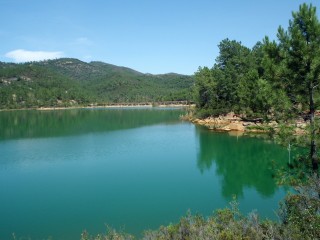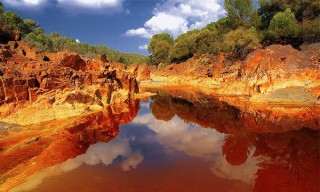Sierra de Aracena
The Sierra de Aracena is situated towards the northern boundary of Huelva province close to the Portuguese border. It is a scenic area of wooded, rolling hillsides and whitewashed villages, which are very picturesque. The guide books tell you that the best time to visit is in the spring when an 'incredible profusion of wild flowers colonize a verdant sierra' or in the autumn when 'the chestnut trees are ablaze and the orchards are laden with fruit'.
 We visited the area in May 2008 with our friends, Jo and Roger. We had booked into a small posada in Alájar, which was a perfect base for exploring the area. The posada boasted organic breakfasts which, for one or two days were fine but after a week of the same fare we were all looking forward to a very 'inorganic' breakfast. However, the accommodation was comfortable and the hosts a very amiable and helpful couple.
We visited the area in May 2008 with our friends, Jo and Roger. We had booked into a small posada in Alájar, which was a perfect base for exploring the area. The posada boasted organic breakfasts which, for one or two days were fine but after a week of the same fare we were all looking forward to a very 'inorganic' breakfast. However, the accommodation was comfortable and the hosts a very amiable and helpful couple.
Swinging my 'kitten heels' out of our vehicle onto the rounded cobbles of one of the plazas on the day of our arrival, I realized immediately that I had packed the wrong kind of clothing for the evenings. The guide books describe Alájar as having five restaurants to choose from, all sounding good, and I pictured us trying a different one on each of the balmy May evenings that we stayed there. Of course, the reality is always different to the anticipation. The first night we struggled to find a restaurant open until we did find a bar that also sold pizzas and although the ambience of the seating area was not as auspicious as we would have liked, the pizzas were surprisingly good.
 The next day we awoke to blue skies and relatively warm weather. Jo had a book of walks in the area (Walking in Andalucia- Guy Hunter-Watts) and each had an intriguing name. The one we chose was no exception and was named 'The Walk of the Bountiful Dehesa' (a Dehesa being the Spanish for an area of forest that has been partially cleared). On reflection, the memory I have of that walk was of the riot of colour that the flowers created, carpeting the ground all around the paths and of the Cistus flowers that were growing from bushes, sometimes over six feet high, with their huge white flowers and dramatic dark plum and golden centres. I must mention here also, the gossamer fluff that was falling from above like snow in certain places, covering the vegetation in a mantle of down. During our stay, we saw this phenomena several times and found it was always around poplar trees. We reached the village of Linares and had an excellent tapas lunch before walking back to Alájar via a different steep, uphill route. During this climb, we encountered our first downpour, which was heavy and steady but once the rain stopped the sun came out and soon dried our wet attire.
The next day we awoke to blue skies and relatively warm weather. Jo had a book of walks in the area (Walking in Andalucia- Guy Hunter-Watts) and each had an intriguing name. The one we chose was no exception and was named 'The Walk of the Bountiful Dehesa' (a Dehesa being the Spanish for an area of forest that has been partially cleared). On reflection, the memory I have of that walk was of the riot of colour that the flowers created, carpeting the ground all around the paths and of the Cistus flowers that were growing from bushes, sometimes over six feet high, with their huge white flowers and dramatic dark plum and golden centres. I must mention here also, the gossamer fluff that was falling from above like snow in certain places, covering the vegetation in a mantle of down. During our stay, we saw this phenomena several times and found it was always around poplar trees. We reached the village of Linares and had an excellent tapas lunch before walking back to Alájar via a different steep, uphill route. During this climb, we encountered our first downpour, which was heavy and steady but once the rain stopped the sun came out and soon dried our wet attire.
The following day, we spent touring the area in the car. Our first stop was at Fuenteheridos for coffee. Like many Serrano villages it has a plentiful supply of spring water, which flows continuously from the fountain with twelve jets (Fuente de Doce Caños). The village was pretty with an attractive main square. From here we travelled on through rolling wooded countryside to Almonaster la Real. Above the town, there is a mosque dating from the 10th century situated amongst the ruins of a castle. The mezquita's mihrab (prayer niche facing Mecca ) is the oldest example of its kind in Spain. It has been restored sensitively and as well as a minaret, has many arches supporting the ceiling in the style of the Mezquita, in Cordoba, but on a much smaller scale. It was all very interesting. On our return journey we stopped briefly in Castaño del Robledo, which seemed drab and bleak in comparison to Almonaster la Real. It was a contrast that we encountered more than once on our travels.
We woke up to dull, cloudy weather and decided to visit Aracena where there were some underground caves - Gruta de las Maravillas. These caves were, to say the least, spectacular and reputed to be amongst the best caves in Spain. They are situated underneath the castle hill and consist of twelve caves with underground lakes and fantastic limestone formations.
We emerged into dazzling sunshine and decided to take a second walk from the book called "The Walk of the Happy Pigs" This was a lovely walk in very different surroundings to our previous walk and yes, we did see many pigs. I think they were happy, lying around in open pastures with acorns to feed on. We eventually arrived at our destination, Carboneras, another whitewashed, sleepy village where the guidebook stated we could ring for a taxi to take us back to Aracena. We couldn't find a public phone and couldn't raise a signal on the mobile. We enquired with the locals about buses and taxis but, although they tried to be helpful, the answer was in the negative. We asked how far it was to Aracena and the answer was 3km, which didn't seem too bad. What they forgot to tell us was, however, that it was uphill all the way.
The next day we decided to follow a short walk in a pamphlet that the proprietor of the hotel kindly had given us written in Spanish. Needless to say we got lost. With much pondering, twisting and turning the map, asking the locals and "Is it this way or that?" we finally found our destination, Santa Ana, where we had the most delicious pork sandwiches on lovely, crusty bread, the highlight of the day.
Our last day proved damp so we headed off to the mining village of the Rio Tinto. In 1873, a British financial concern bought the mines of the Rio Tinto, thus forming the Rio Tinto Company Ltd. There had been mines in the area for centuries, in fact in the museum they have a replica of an ancient mine, complete with manacled slave, from the Roman era.  However, when the British arrived they decided to build a barrio (district/neighbourhood) for their English staff and families on a hill, which was known locally as beautiful hill. The barrio is still there today and you can visit one of the semi-detached houses, which was the home of the Director General. Our guide there was very informative but the museum in the town held most of the photographic evidence of the daily life of the Victorian settlers. They showed the tennis courts, the scout movement, sewing classes for the ladies and other such British institutions along with a street party in honour of Queen Victoria's birthday. It was truly a little England, situated in the middle of Huelva province m the eighteen hundreds. When we walked down the street of semi-detached houses in the barrio we could recognize where the children had raced as depicted in the photographs. It was fascinating. There was so much more to do, such as an open train ride to the quarry whose sides were colourfully spectacular due to the minerals in the soil, but the weather was letting us down and we returned to Alájar.
However, when the British arrived they decided to build a barrio (district/neighbourhood) for their English staff and families on a hill, which was known locally as beautiful hill. The barrio is still there today and you can visit one of the semi-detached houses, which was the home of the Director General. Our guide there was very informative but the museum in the town held most of the photographic evidence of the daily life of the Victorian settlers. They showed the tennis courts, the scout movement, sewing classes for the ladies and other such British institutions along with a street party in honour of Queen Victoria's birthday. It was truly a little England, situated in the middle of Huelva province m the eighteen hundreds. When we walked down the street of semi-detached houses in the barrio we could recognize where the children had raced as depicted in the photographs. It was fascinating. There was so much more to do, such as an open train ride to the quarry whose sides were colourfully spectacular due to the minerals in the soil, but the weather was letting us down and we returned to Alájar.
The scenery of the Sierra Aracena is certainly stunning but like all places needs the sunshine to display it at its best. Perhaps we were unlucky in choosing a week when the weather occasionally failed to enhance the area's obvious potential. Some of the villages were very pretty and others seemed stuck in a time warp. We had a great time and although my expectation was not quite like the reality, I certainly didn't feel disappointed. Everyday brought a different, varied experience that I wouldn't like to have missed and confirms my judgement that the more I get to know this country, the more I look forward with anticipation to my next sojourn in yet another, different region of Spain.
This article is based on an article originally appearing in the Cabrera Courier.
When visiting the Sierra de Aracena, choose:
Posada Finca La Fronda, just outside Alájar
16 Feb 2016, 17:15